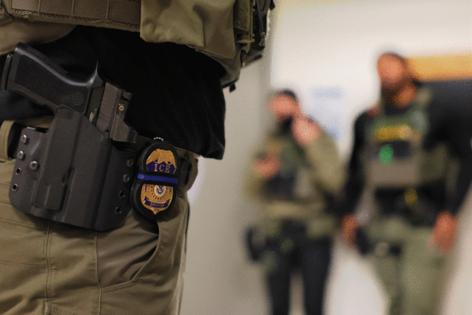Hundreds of immigrants are filling jails in outstate Missouri after ICE arrests
Published in News & Features
ROLLA, Mo. — The immigration officer called on a Tuesday.
He told Willians Alvarenga-Calix that he needed to come check in. It’d be quick, the officer said; he just needed to verify some paperwork.
Now, nearly two weeks later, Alvarenga-Calix is locked up at a county jail here, 100 miles from his home. He was arrested at the immigration supervision office and driven in a van to Phelps County.
“They tricked me,” he said in Spanish.
And most of the new arrivals in his wing, he says, are coming from St. Louis.
Over the past several months, federal immigration authorities have arrested and shipped hundreds of immigrants from across the state to at least three county jails in outstate Missouri as part of President Donald J. Trump’s nationwide effort to deport illegal immigrants, according to public records in each county and interviews with inmates, attorneys and officials.
The three jails — in Phelps, Ste. Genevieve and Greene counties — have contracts with the federal government to house people detained by U.S. Immigration and Customs Enforcement, or ICE, according to county records and officials. The Post-Dispatch analyzed population data from each of the facilities and found they’ve been taking more and more people in recent months.
Jessica Mayo, an attorney and co-founder of the nonprofit Migrant and Community Action Project, said that tracked with her experience. In addition to the influx of arrests, people are moving through the process toward deportation much more quickly.
“By the time we get a call and get an appointment spot at the jails, they’ve often been moved,” she said.
At the three jails, inmate populations have risen collectively by more than 500 people over five months, a bump of about one-quarter:
The population of the Phelps County jail, in Rolla, grew from a total of 409 people in early January to 579 by the end of May. In Ste. Genevieve, the jail population went from an average of 340 people per day in January to 400 in May.
And the Greene County Jail, in Springfield, now has more than 1,000 inmates, a growth of about 300 this year. Greene County officials said on Thursday the jail was housing 282 ICE detainees after months of hovering around 250.
And they expected to see 150 new federal detainees arrive within the week, Sheriff Jim Arnott said at a county commissioners meeting.
“We have the capacity,” he told the commission.
Officials with ICE and with Phelps and Ste. Genevieve counties either didn’t respond to a requests for comment or declined to discuss the contracts.
‘They pay on a timely basis’
ICE often contracts with private companies to run standalone immigration detention facilities.
And for years, local jails and sheriff’s departments have supplemented those, getting paid by the federal government to house extra ICE detainees.
But over the past several months, more and more sheriff’s departments have been signing on, according to multiple national reports, as the Trump administration attempts to arrest and deport record numbers of people.
ICE’s own numbers show significant growth in arrests nationally: 51,302 people this fiscal year, ending Sept. 30, compared with 37,684 in the prior fiscal year.
About 30% of those detained this year have a prior criminal record, according to the ICE statistics, and 26% are currently facing criminal charges. About 44% have no reported criminal history.
The county jails in Rolla, Ste. Genevieve and Springfield have been taking federal inmates for years.
Maj. Jason Schott, of the Ste. Genevieve Sheriff’s Department, would not discuss the specifics of the county’s agreement with ICE, nor provide the number of immigration detainees. The Phelps County sheriff did not respond to repeated requests for comment.
In Springfield, the jail has long housed hundreds of federal detainees awaiting trial or transfer to the federal prisons. Last year, the sheriff’s department added immigration detainees to its list.
As of Thursday, federal inmates accounted for 40% of the roughly 1,140 people in jail there. Arnott, the sheriff, told commissioners in the meeting they were seeking even more money for each of them — as much as $161 per federal detainee per day, up from $100.
With the current population, it would be an increase of $28,000 a day.
Presiding Commissioner Bob Dixon noted at the meeting that costs have likely gone up with the increase in federal population.
“The good thing is, at least they pay on a timely basis,” he said.
Mayo, the immigration attorney, said Greene County has been used to house people with deportation orders. After that, she said, they might get sent to another facility before they’re deported.
Mayo’s group tries to intervene. But in some cases, the person is taken away before her team can get there.
“A lot of times there aren’t many options,” she said.
Alvarenga-Calix, the detainee in Rolla, is being held in a cell with a half-dozen other men from countries including Mexico, Honduras and Iraq.
Alvarenga-Calix, 32, said in an interview through the jail’s video call system that he had been deported back to Honduras twice in the 2010s. But the country had grown increasingly dangerous in recent years, he said. He was extorted. His wife and children were in danger.
So he and his son, now 9, came to the U.S. in 2023 and landed in south St. Louis County to be near family. His son enrolled in school and has a pending asylum claim.
Alvarenga-Calix said he has no criminal history outside of a couple of traffic offenses, for illegal parking and driving without a valid license. Missouri and federal court records do not otherwise list him.
And he said he has followed all of the directives from immigration officers.
He checked in regularly at an office in downtown St. Louis and through video calls at his home. A lawyer was working on getting him a permit so he could go to work.
Seeking asylum
On June 3, Alvarenga-Calix had a video check-in scheduled with his immigration officer. He asked about a text he’d received the day before telling him to come in.
He left his son with a cousin while he went in, thinking it would be quick. Instead, he said, the officer told him to empty his pockets.
The officer shackled his hands and feet. They took his shoelaces.
“They took me handcuffed like a criminal,” he said. “I mean, I’m not going to escape. I had already turned myself in to them. They already know where I live.”
In Rolla, Alvarenga-Calix has watched people come and go. He estimates there are around 30 ICE detainees in the annex where he is housed.
One of his cellmates is Juan Alas-Menjivar — another Honduran immigrant seeking asylum in the U.S.
Alas-Menjivar had previously been deported but came to the U.S. again last year with his son, he and his lawyer said. Gangs had killed several members of his family, he said, including his brother and stepfather, after a relative had gotten crosswise with the group.
His sister was already living in St. Louis, so he and his son settled on Cherokee Street in the city. He had a legal permit to work in construction.
Since he arrived, Alas-Menjivar’s attorney, Hannah Sullivan, has been requesting something called a credible fear interview, which is the first step in the asylum process.
In those interviews, the applicant sits down with an asylum officer to talk about why they fear persecution in their home country. If they pass, they can move forward to the asylum process.
People who have been previously deported can’t be granted full asylum. But they can be given “withholding of removal,” which means they can’t be deported to their home country. That often means they continue to live in the U.S. with documentation including work permits, driver’s licenses and social security cards.
Sullivan said there are typically yearslong delays with scheduling credible fear interviews — especially for people like Alas-Menjivar who are following the rules and regularly checking in with immigration authorities.
His detention means his interview could actually become a higher priority, speeding up the process, she said.
“This is something we’ve been asking for since they got back in May 2024,” she said.
Alvarenga-Calix is also waiting. He is trying to seek asylum, he said, but he’s uncertain.
He hears people’s names being called every day over the loudspeaker in the jail, telling them to get ready to be shipped out. He never knows where they’re going.
He worries one day his name will be called. He worries about being told to pack up and go without his son.
“Even though I feel all the pain in the world and although I fear for my life, I will take my son,” he said. “No one can care for my son like I can.”
Protesters crowd around City Hall for anti-Trump 'No Kings' demonstration in Los Angeles
In Los Angeles, thousands gathered in front of City Hall Saturday. This comes after the Trump administration deployed 4,700 Marines and National Guard troops to the city earlier in the week.
Thousands protest across St. Louis region against Trump cuts, immigration arrests
Several of the protests appeared to be family events, with lawn chairs, flags, dogs and kids. The Missouri National Guard were not reported at the rallies.
Immigrant arrests rise in St. Louis. ‘Definitely an uptick’
Norma Adriana Padilla Rivera's father was one of at least 10 arrested by immigration officials in St. Louis this week.
A text from ICE and a tense check-in for St. Louis immigrant. He and others fear arrest.
"Once you go through that door, you're probably not coming out," an attorney says.
©2025 STLtoday.com. Distributed by Tribune Content Agency, LLC.







Comments